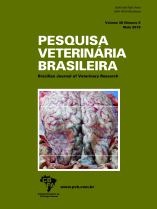 |
|
|
|
Year 2018 - Volume 38, Number 5
|

|
Seropositivity and risk factors for leptospirosis, toxoplasmosis and neosporosis in the canine population of Paraiba state, northeastern Brazil, 38(5):957-966
|
ABSTRACT.- Fernandes A.R.F., Costa D.F., Andrade M.R., Bezerra C.S., Mota R.A., Alves C.J., Langoni H. & Azevedo S.S. 2018. [Seropositivity and risk factors for leptospirosis, toxoplasmosis and neosporosis in the canine population of Paraiba state, northeastern Brazil.] Soropositividade e fatores de risco para leptospirose, toxoplasmose e neosporose na população canina do Estado da Paraíba. Pesquisa Veterinária Brasileira 38(5):957-966. Laboratório de Doenças Transmissíveis, Unidade Acadêmica de Medicina Veterinária, Universidade Federal de Campina Grande, Av. Universitária s/n, Santa Cecília, Patos, PB 58700-970, Brazil. E-mail: sergio@vps.fmvz.usp.br
The aim of this study was to determine the frequency of seropositive animals for Leptospira spp., Toxoplasma gondii and Neospora caninum in dogs from Paraiba state, northeastern Brazil, and to identify risk factors. A total of 1,043 sera were sampled from dogs from five urban centers considered as regional poles: João Pessoa, Campina Grande, Patos, Sousa and Cajazeiras. For the serological diagnosis of Leptospira spp. infection the microscopic agglutination test (MAT) was used, and for detecting anti-T. gondii and N. caninum antibodies the indirect fluorescent antiboy test (IFAT) was carried out. Ninety-seven dogs showed anti‑Leptospira spp. agglutinins, resulting in a frequency of 9.3% (95% CI=7.5; 11.1%). The most frequente serovars were Icterohaemorragiae (47.4%), Copenhageni (16.5%), Bratislava (11.3%), Canicola (10.3%) and Pomona (6.2%). The seropositivities for T. gondii and N. caninum were 22.1% (231/1043; 95% CI=19.6; 24.7%) and 7.7% (80/1043; 95% CI=6.1; 9.3%) respectively. Age >48 months (OR=2.92), mixed breed (OR=1.94) and access to street (OR=1.57) were identified as risk factors for Leptospira spp. infection. For toxoplasmosis, the categories age >48 months (OR=1.74), homemade food (OR=2.24), comercial and homemade food (OR=2.34) and contact with cats (OR=1.57) were considered risk factors, while access to street (OR=2.62) was risk fator for N. caninum. We conclude that dogs from five urban centers in Paraiba state are exposed to Leptospira spp., T. gondii and N. caninum infections, evidenced by antibody detection, as well as it is suggested a better feed management, control of outside home environment access and proper disposal of cat feces. |
| |
|
|
| |
|
 |